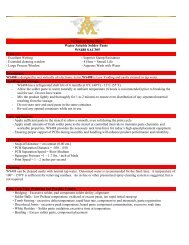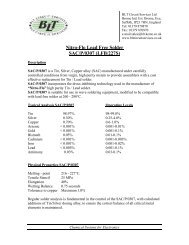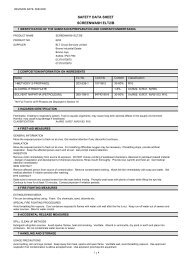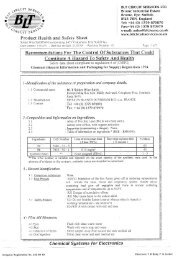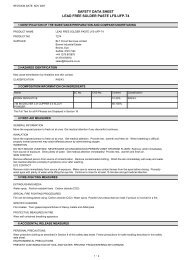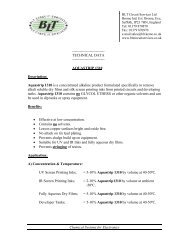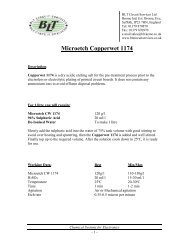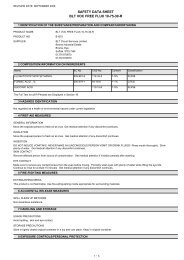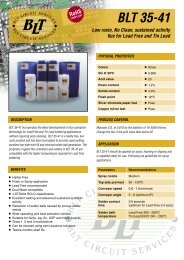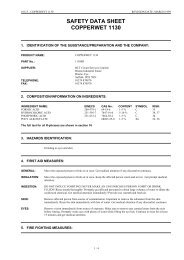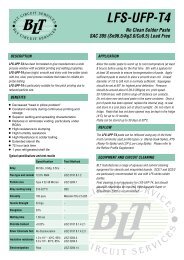Material Safety Data Sheet - BLT Circuit Services
Material Safety Data Sheet - BLT Circuit Services
Material Safety Data Sheet - BLT Circuit Services
Create successful ePaper yourself
Turn your PDF publications into a flip-book with our unique Google optimized e-Paper software.
Section 1. Product and Company Identification<br />
<strong>Material</strong> <strong>Safety</strong> <strong>Data</strong> <strong>Sheet</strong><br />
Common Name<br />
Product type<br />
Synonym<br />
Alloy SAC 305<br />
Metal alloy<br />
Alloy LF 218<br />
Code<br />
Not available<br />
Validation Date 2004-08-30<br />
Version number 2<br />
<strong>Material</strong> Uses<br />
Supplier<br />
Manufacturer<br />
Industrial applications: Soldering<br />
AIM<br />
AIM<br />
In Case of<br />
Emergency<br />
INFOTRAC<br />
(North America): (800) 535-5053<br />
(International): (352) 323-3500<br />
Section 2. Hazardous Components<br />
Name CAS # % by Weight Toxicity <strong>Data</strong> ( LC50/LD50, TLV)<br />
1) Tin 7440-31-5 96.5 TWA: 2 (mg/m 3 ) from OSHA (PEL) [United States]<br />
[1997] INHALATION Respirable.<br />
TWA: 2 (mg/m 3 ) from ACGIH (TLV) [United States]<br />
[1994] INHALATION Respirable.<br />
2) Silver 7440-22-4 3 TWA: 0.1 (mg/m 3 ) from ACGIH (TLV) [United States]<br />
[1994] INHALATION<br />
Section 3. Hazards Identification<br />
Physical State and<br />
Appearance<br />
Emergency Overview<br />
Solid.<br />
WARNING!!<br />
Avoid contact with eyes Avoid prolonged or repeated contact with skin. Wash thoroughly after<br />
handling.<br />
Routes of Entry<br />
Inhalation. Ingestion.<br />
Potential Acute Health Effects<br />
Potential Chronic Health<br />
Effects<br />
Eyes This product may be hazardous in case of eye contact (irritant).<br />
Skin This product may be hazardous in case of skin contact (irritant, sensitizer).<br />
Inhalation Fumes and/or dusts produced by this product may be hazardous in case of inhalation.<br />
Ingestion This product may be hazardous in case of ingestion.<br />
Medical Conditions Repeated or prolonged exposure is not known to aggravate medical condition.<br />
Aggravated by Overexposure:<br />
Overexposure<br />
/Signs/Symptoms<br />
Not available.<br />
See Toxicological Information (section 11)<br />
Chronic effects: Chronic effects: Fumes and/or dusts produced by this product may be hazardous in<br />
case of ingestion, of inhalation.<br />
This product may be hazardous in case of skin contact (irritant, sensitizer), of eye contact (irritant).<br />
Non-corrosive for skin. Non-permeator by skin.<br />
Continued on Next Page
Alloy SAC 305 Page: 2/6<br />
Section 4. First Aid Measures<br />
Eye Contact<br />
Skin Contact<br />
Hazardous Skin Contact<br />
Inhalation<br />
Hazardous Inhalation<br />
Ingestion<br />
Hazardous Ingestion<br />
Notes to Physician<br />
Check for and remove any contact lenses. In case of contact, immediately flush eyes with plenty of<br />
water for at least 15 minutes. Get medical attention.<br />
In case of contact, immediately flush skin with plenty of water for at least 15 minutes while removing<br />
contaminated clothing and shoes. Cover the irritated skin with an emollient. Wash clothing before<br />
reuse. Thoroughly clean shoes before reuse. Get medical attention.<br />
Wash with a disinfectant soap and cover the contaminated skin with an anti-bacterial cream. Seek<br />
medical attention.<br />
If inhaled, remove to fresh air. If not breathing, give artificial respiration. If breathing is difficult, give<br />
oxygen Get medical attention.<br />
Not available.<br />
Do NOT induce vomiting unless directed to do so by medical personnel. Never give anything by mouth<br />
to an unconscious person. If large quantities of this material are swallowed, call a physician<br />
immediately. Loosen tight clothing such as a collar, tie, belt or waistband.<br />
Not available.<br />
Not available.<br />
Section 5. Fire Fighting Measures<br />
Flammability of the Product<br />
Auto-Ignition Temperature<br />
Flash Points<br />
Flammable Limits<br />
Products of Combustion<br />
Fire Hazards in Presence of<br />
Various Substances<br />
Explosion Hazards in<br />
Presence of Various<br />
Substances<br />
Fire Fighting Media<br />
and Instructions<br />
Protective Clothing (Fire)<br />
Non-flammable.<br />
Not applicable.<br />
Not applicable.<br />
Not applicable.<br />
Not available.<br />
Not applicable.<br />
Non-explosive in presence of open flames and sparks, of shocks.<br />
Not applicable.<br />
Not applicable.<br />
Special Remarks on Fire<br />
Hazards<br />
Special Remarks on<br />
Explosion Hazards<br />
Not available.<br />
Not available.<br />
Section 6. Accidental Release Measures<br />
Small Spill and Leak<br />
Large Spill and Leak<br />
Use appropriate tools to put the spilled solid in a convenient waste disposal container. Finish cleaning<br />
by spreading water on the contaminated surface and dispose of according to local and regional<br />
authority requirements.<br />
Use a shovel to put the material into a convenient waste disposal container. Finish cleaning by<br />
spreading water on the contaminated surface and allow to evacuate through the sanitary system. Be<br />
careful that the product is not present at a concentration level above TLV. Check TLV on the MSDS<br />
and with local authorities.<br />
Continued on Next Page
Alloy SAC 305 Page: 3/6<br />
Section 7. Handling and Storage<br />
Handling<br />
Storage<br />
Avoid contact with eyes Avoid prolonged or repeated contact with skin. Wash thoroughly after<br />
handling.<br />
Keep container tightly closed. Keep container in a cool, well-ventilated area.<br />
Section 8. Exposure Controls, Personal Protection<br />
Engineering Controls<br />
Personal Protection<br />
Eyes<br />
Use process enclosures, local exhaust ventilation, or other engineering controls to keep airborne<br />
levels below recommended exposure limits. If user operations generate dust, fume or mist, use<br />
ventilation to keep exposure to airborne contaminants below the exposure limit.<br />
Splash goggles.<br />
Body<br />
Lab coat.<br />
Respiratory<br />
Hands<br />
Dust respirator. Be sure to use an approved/certified respirator or equivalent. Wear appropriate<br />
respirator when ventilation is inadequate.<br />
Gloves.<br />
Feet<br />
Not applicable.<br />
* Note:Suggested protective clothing may not be adequate for a specific process. Consult a specialist before using.<br />
Personal Protection in Case<br />
of a Large Spill<br />
Product Name<br />
Splash goggles. Full suit. Dust respirator. Boots. Gloves. A self contained breathing apparatus<br />
should be used to avoid inhalation of the product. Suggested protective clothing might not be<br />
sufficient; consult a specialist BEFORE handling this product.<br />
Exposure Limits<br />
1) TIN TWA: 2 (mg/m 3 ) from OSHA (PEL) [United States] [1997] INHALATION Respirable.<br />
TWA: 2 (mg/m 3 ) from ACGIH (TLV) [United States] [1994] INHALATION Respirable.<br />
2) SILVER TWA: 0.1 (mg/m 3 ) from ACGIH (TLV) [United States] [1994] INHALATION<br />
Consult local authorities for acceptable exposure limits.<br />
Section 9. Physical and Chemical Properties<br />
Physical State and<br />
Appearance<br />
Solid.<br />
Odor<br />
Not available.<br />
Molecular Weight<br />
Not applicable.<br />
Taste<br />
Not available.<br />
Chemical formula<br />
Not applicable.<br />
Color<br />
silver-grey<br />
pH (1% Soln/Water)<br />
Not applicable.<br />
Specific Gravity<br />
Weighted average: 7.38 (Water = 1)<br />
Acid Value (IPC TM-650,<br />
2.3.13)<br />
Not available.<br />
Boiling/Condensation Point<br />
Not available.<br />
Melting/Freezing Point<br />
217-218 C<br />
Critical Temperature<br />
Not available.<br />
Vapor Pressure<br />
Not applicable.<br />
Vapor Density<br />
Not available.<br />
Volatility<br />
Not available.<br />
Odor Threshold<br />
Not available.<br />
Evaporation Rate<br />
Not available.<br />
Continued on Next Page
Alloy SAC 305 Page: 4/6<br />
VOC<br />
Not available.<br />
Viscosity<br />
LogK ow<br />
Ionicity (in Water)<br />
Dispersion Properties<br />
Solubility<br />
Not available.<br />
The product is insoluble in water and oil.<br />
Non-ionic.<br />
Is not dispersed in cold water, hot water, methanol, diethyl ether, n-octanol, acetone.<br />
Insoluble in cold water, hot water, methanol, diethyl ether, n-octanol, acetone.<br />
Physical Chemical Comments Not available.<br />
Section 10. Stability and Reactivity<br />
Stability and Reactivity<br />
Conditions of Instability<br />
Incompatibility with Various<br />
Substances<br />
Hazardous Decomposition<br />
Products<br />
Hazardous Polymerization<br />
Corrosivity<br />
Special Remarks on<br />
Corrosivity<br />
The product is stable.<br />
Stable in normal conditions. Over melting point, will emit toxic tin oxides. (Tin)<br />
Slightly reactive with oxidizing agents, acids, moisture.<br />
Not available.<br />
Will not occur.<br />
Not considered to be corrosive for metals and glass according to our database.<br />
Not available.<br />
Section 11. Toxicological Information<br />
Toxic and Chronic Effects on<br />
Humans<br />
Toxicity to Animals<br />
Fumes and/or dusts produced by this product may be hazardous in case of ingestion, of inhalation.<br />
This product may be hazardous in case of skin contact (irritant, sensitizer), of eye contact (irritant).<br />
Non-corrosive for skin. Non-permeator by skin.<br />
CARCINOGENIC EFFECTS: Classified NONE by NIOSH [Tin]. Classified NONE by NIOSH [Silver].<br />
Classified NONE by NIOSH [Copper].<br />
MUTAGENIC EFFECTS: Not available.<br />
TERATOGENIC EFFECTS: Not available.<br />
DEVELOPMENTAL TOXICITY: Not available.<br />
The product may be toxic to kidneys, lungs, liver, mucous membranes, upper respiratory tract, skin,<br />
eye, lens or cornea.<br />
Repeated or prolonged exposure to the substance can produce target organs damage.<br />
LD50: Not available.<br />
LC50: Not available.<br />
Special Remarks on Chronic<br />
Effects on Humans<br />
Special Remarks on Other<br />
Toxic Effects on Humans<br />
Special Remarks on Toxicity<br />
to Animals<br />
Prolonged and repeated exposure to tin oxyde fumes may result in benigne pneumoconiosis<br />
(stannosis). (Tin)<br />
MOLTEN METAL can cause severe BURNS!<br />
Fumes and dust may irritate eyes, digestive system and respiratory tract.<br />
(Tin)<br />
No additional remark. (Tin)<br />
Continued on Next Page
Alloy SAC 305 Page: 5/6<br />
Section 12. Ecological Information<br />
Ecotoxicity<br />
BOD5 and COD<br />
Biodegradable/OECD<br />
Mobility<br />
Not available.<br />
Not available.<br />
Not available.<br />
Not available.<br />
Possibly hazardous short term degradation products are not likely. However, long term degradation<br />
products may arise.<br />
Toxicity of the Products of<br />
Biodegradation<br />
Special Remarks on the<br />
Products of Biodegradation<br />
The product itself and its products of degradation are not toxic.<br />
Not available.<br />
Section 13. Disposal Considerations<br />
Waste Information<br />
Waste Stream<br />
Waste must be disposed of in accordance with federal, state and local environmental control<br />
regulations.<br />
Not available.<br />
Consult your local or regional authorities.<br />
Section 14. Transport Information<br />
DOT Classification<br />
Not a DOT controlled material (United States).<br />
Not regulated<br />
Special Provisions for<br />
Transport<br />
Not applicable.<br />
Special Provisions for<br />
Transport<br />
IMO/IMDG Classification<br />
Marine Pollutant<br />
Not controlled under IMDG.<br />
Not available.<br />
ADR/RID Classification<br />
ICAO/IATA Classification<br />
Not controlled under ADR (Europe).<br />
Not controlled under IATA.<br />
Section 15. Regulatory Information<br />
HCS Classification<br />
U.S. Federal Regulations<br />
Class: Sensitizing substance.<br />
Class: Target organ effects.<br />
TSCA 8(a) PAIR: Silver<br />
TSCA inventory: Tin; Silver; Copper<br />
SARA 302/304/311/312 extremely hazardous substances: No products were found.<br />
SARA 302/304 emergency planning and notification: No products were found.<br />
SARA 302/304/311/312 hazardous chemicals: Tin; Silver; Copper<br />
SARA 311/312 MSDS distribution - chemical inventory - hazard identification: Tin: immediate health<br />
hazard; Silver: immediate health hazard; Copper: immediate health hazard<br />
SARA 313 toxic chemical notification and release reporting: Silver: 1%; Copper: 1%<br />
Clean water act (CWA) 307: Silver; Copper<br />
Clean water act (CWA) 311: No products were found.<br />
Continued on Next Page
Alloy SAC 305 Page: 6/6<br />
State Regulations<br />
Clean air act (CAA) 112 accidental release prevention: No products were found.<br />
Clean air act (CAA) 112 regulated flammable substances: No products were found.<br />
Clean air act (CAA) 112 regulated toxic substances: No products were found.<br />
Rhode Island RTK hazardous substances: Tin<br />
Pennsylvania RTK: Tin: (generic environmental hazard); Silver: (environmental hazard, generic<br />
environmental hazard); Copper: (environmental hazard)<br />
Florida: Tin; Silver<br />
Minnesota: Tin; Silver<br />
Michigan critical material: Silver<br />
Massachusetts RTK: Tin; Silver; Copper<br />
New Jersey: Tin; Silver; Copper<br />
New Jersey spill list: Tin<br />
California prop. 65: No products were found.<br />
International Regulations<br />
EINECS<br />
DSCL (EEC)<br />
International Lists<br />
Not available.<br />
36/38- Irritating to eyes and skin.<br />
43- May cause sensitization by skin contact.<br />
Australia (NICNAS): Tin; Silver; Copper<br />
Section 16. Other Information<br />
Korea (TCCL): Tin; Silver; Copper<br />
Philippines (RA6969): Tin; Silver; Copper<br />
Hazardous <strong>Material</strong><br />
Information System<br />
(U.S.A.)<br />
Health<br />
Fire Hazard<br />
Reactivity<br />
Personal Protection<br />
* 1 National Fire<br />
0 Protection<br />
Association (U.S.A.)<br />
1<br />
E<br />
Health<br />
1<br />
0<br />
1<br />
Fire Hazard<br />
Reactivity<br />
Specific Hazard<br />
Label statements<br />
CONTAINS MATERIAL WHICH CAUSES DAMAGE TO THE FOLLOWING ORGANS: KIDNEYS, LUNGS,<br />
LIVER, MUCOUS MEMBRANES, RESPIRATORY TRACT, SKIN, CRYSTALLINE LENS OR CORNEA.<br />
MAY CAUSE EYE AND SKIN IRRITATION.<br />
MAY CAUSE ALLERGIC SKIN REACTION.<br />
References<br />
Other Special<br />
Considerations<br />
Not available.<br />
Not available.<br />
Document<br />
Modifications<br />
Validated by R. Richard on 2004-08-30.<br />
Verified by R. Richard.<br />
Printed 2004-09-13.<br />
Information/Contact<br />
AIM<br />
25 Kenney Drive, Rhode Island, USA, 02920<br />
(401) 463-5605 (800) CALL AIM<br />
Notice to Reader<br />
To the best of our knowledge, the information contained herein is accurate. However, neither the above named supplier nor any of its subsidiaries assumes any liability whatsoever<br />
for the accuracy or completeness of the information contained herein.<br />
Final determination of suitability of any material is the sole responsibility of the user. All materials may present unknown hazards and should be used with caution. Although<br />
certain hazards are described herein, we cannot guarantee that these are the only hazards that exist.



